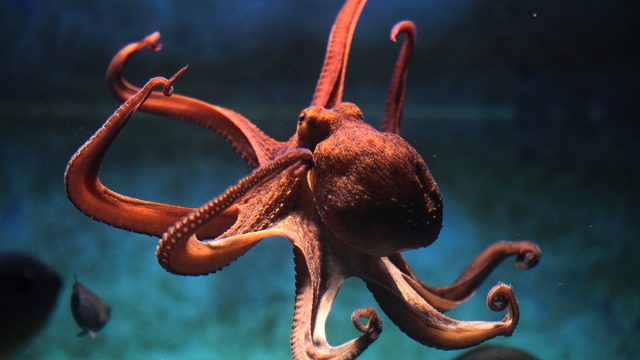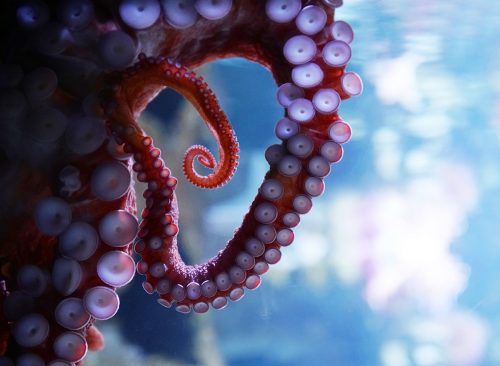Video Shows Octopuses Throwing Shells at Each Other When They Get Mad
"Just doing their own weird thing."

The octopus seems like a fairly docile creature, a slow-moving, solitary, snoozy resident of the sea. But it turns out octopuses, like many species, are prone to be disturbed by their peers to the point they feel the need to make a statement—tossing things at them. Researchers at the University of Sydney have captured video of octopuses gathering deep-sea material like silt and shells and seemingly throwing them at other members of their species.
They published their findings this week in the journal PLoS One. If octopuses do indeed throw things at each other, that would put them in an exclusive group of animals. Read on to find out what that is and how they do it (Spoiler alert: They don’t actually use their numerous arms.)—and to boost your brain, don’t miss these mind-blowing The 10 Most “OMG” Science Discoveries of 2022

Peter Godfrey-Smith of the University of Sydney told NPR that the study came about after researchers observed an octopus dropping shells on top of another octopus. They scrutinized the tape, trying to determine if it was accidental or intentional. Ultimately, they submerged several GoPro cameras off the Australian coast to study the behavior of the so-called “gloomy octopus.”
“And we began to see these more dramatic cases, where an octopus will gather a bunch of stuff in its arms, sometimes move a little bit forward and then sort of blast out the material, releasing it from the arms and applying pressure from the jet propulsion device that they have,” said Godfrey-Smith. The scientists observed more than 100 instances of this. Keep reading to learn more and see the video.

After studying the behavior, the researchers determined that the octopuses appeared to aim at others intentionally, and targets sometimes ducked or raised their arms. But there isn’t really a word for what the gloomy octopus does, Godfrey-Smith told the New York Times.
For example: If an octopus feels provoked by its neighbor, it will gather silt from the seafloor underneath its body and hold it there. It will position its siphon, a tubular organ used to pump water for swimming, underneath itself. Then it will expel water to push the material forward.

But did the octopuses really intend to aim at one of their neighbors? The research team observed that debris that hit another octopus was thrown in a distinct manner—slightly to the side, not straight ahead. And octopuses seemed to expel different material based on their intention.
When one was seemingly trying to strike another octopus, it ejected silt. But scallop shells were tossed aside casually, like dinner scraps, not a projectile.

The researchers found that about two-thirds of throws were from females, which often came during interactions with other octopuses approaching or attempting to mate. “There is some evidence that some of these throws that hit others are targeted, and play a social role,” the study’s authors wrote.
In one instance recorded in 2016, a female octopus threw things at a male 10 times over three-and-a-half hours, hitting it five times. The targeted octopuses were not observed to retaliate, only trying to move out of the way or raise an arm in defense (not always successfully).

“Octopuses can thus definitely be added to the short list of animals who regularly throw or propel objects, and provisionally added to the shorter list of those who direct their throws on other animals,” the scientists wrote. “If they are indeed targeted, these throws are directed at individuals of the same population in social interactions – the least common form of nonhuman throwing.”
However, the scientists say more research is needed to determine if the behavior is indeed a method of social interaction. “We shouldn’t map it too straightforwardly onto the area of human conflict, human relationships,” Godfrey-Smith told NPR. “Octopuses are just doing their own weird thing. It’s different from what we do.”














